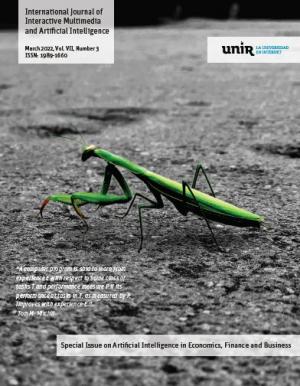Finite Sample Properties of Parameterized Expectations Algorithm Solutions; Is the Length So Determinant?
DOI:
https://doi.org/10.9781/ijimai.2022.02.007Keywords:
Nonlinear Models, Numerical Solution Methods, Optimal Growth, Parameterized Expectations AlgorithmAbstract
The solution of the Parameterized Expectations Algorithm (PEA) is well defined based on asymptotic properties. In practice, it depends on the specific replication of the exogenous shock(s) used for the resolution process. Typically, this problem is reduced when a sufficiently long replication is considered. In this paper, we suggest an alternative approach which consists of using several, shorter replications. A centrality measure (the median) is used then to discriminate among the different solutions using two different criteria, which differ in the information used. On the one hand, the distance to the vector composed by median values of PEA coefficients is minimized. On the other hand, distances to the median impulse response is minimized. Finally, we explore the impact of considering alternative approaches in an empirical illustration.
Downloads
References
L. Christiano, and J.M. Fisher, “Algorithms for Solving Dynamic Models with Occasionally Binding Constraints,” Journal of Economic Dynamics and Control, vol. 24, pp. 1179-1232, 2000, doi: 10.1016/S0165-1889(99)00016-0.
W. den Haan and A. Marcet, “Solving the Stochastic Growth Model by Parameterized Expectations,” Journal of Business and Economic Statistics, vol. 8, pp. 31-34, 1990, doi: 10.1080/07350015.1990.10509770.
W. den Haan and A. Marcet, “Accuracy in Simulations,” Review of Economic Studies, vol. 61, pp. 3-17, 1994, doi: 10.2307/2297873.
B.C. Eaves and K. Schmedders, “General equilibrium models and homotopy methods,” Journal of Economic Dynamics and Control, vol. 23, pp. 1249-1279, 1999, doi: 10.1016/S0165-1889(98)00073-6.
P. Fackler, “A Matlab solver for Nonlinear Rational Expectations Models,” Computational Economics, vol. 26, pp. 173-181, 2005, doi: 10.1007/s10614-005-1784-z.
C.B. Garcia and W.I. Zangwill, “Pathways to solutions, fixed points, and equilibria,” Prentice-Hall, 1981.
S. Maliar and L. Maliar, “Parameterized expectations algorithm and the moving bounds,” Journal of Business and Economic Statistics, vol. 1, pp. 88-92, 2003, doi: 10.1198/073500102288618793.
S. Maliar and L. Maliar, “Parameterized Expectations Algorithm: How to Solve for Labor Easily,” Computational Economics, vol. 25, no. 3, pp. 269- 274, 2005, doi: 10.1007/s10614-005-2224-9.
M. Creel, “Using Parallelization to Solve a Macroeconomic Model: A Parallel Parameterized Expectations Algorithm,” Computational Economics, vol. 32, no. 4, 2008, doi: 10.1007/s10614-008-9142-6.
J.B. Taylor and H. Uhlig, “Solving Nonlinear Stochastic Growth Models: A Comparison of Alternative Solution Methods,” Journal of Business and Economic Statistics, vol. 8, pp. 1–17, 1990, doi: 10.1080/07350015.1990.10509766.
A. Marcet and D.A. Marshall, “Solving Nonlinear Rational Expectations Models by Parameterized Expectations: Convergence to Stationary Solutions,” Institute for Empirical Macroeconomics Discussion Paper 91, 1994, May.
T.F. Cooley, and G. Hansen, “The Inflation Tax in a Real Business Cycle Model,” American Economic Review, vol. 79, pp. 733-748, 1989, doi: 10.4324/9780203070710.ch11.
R.Y. Liu, “On a Notion of Data Depth Based on Random Simplices,” The Annals of Statistics, vol. 18, pp. 405-414, 1990, doi: 10.1214/aos/1176347507.
J.J. Pérez and A.J. Sánchez-Fuentes, “Alternatives to initialize the Parameterized Expectations Algorithm,” Economics Letters, vol. 102, no. 2, pp. 116-118, 2009, doi: 10.1016/j.econlet.2008.11.017.
J.J. Pérez, “A Log-linear Homotopy Approach to Initialize the Parameterized Expectations Algorithm,” Computational Economics, vol. 24, pp. 59-75, 2004, doi: 10.1023/B:CSEM.0000038893.70411.f5.
Y. Zuo and R. Serfling, “General Notions of Statistical Depth Function,” The Annals of Statistics, vol. 28, pp. 461-482, 2000, doi: 10.1214/aos/1016218226.
Downloads
Published
-
Abstract219
-
PDF26









